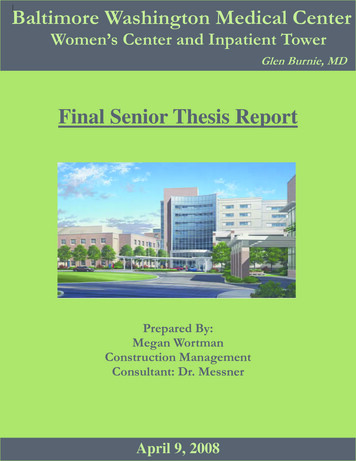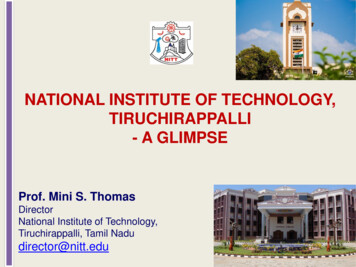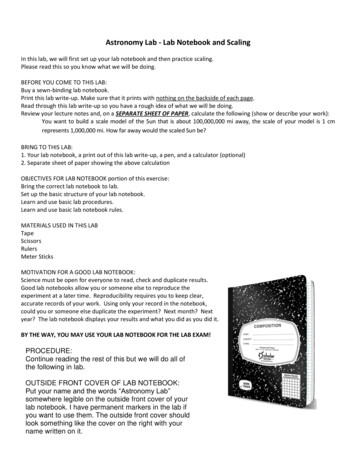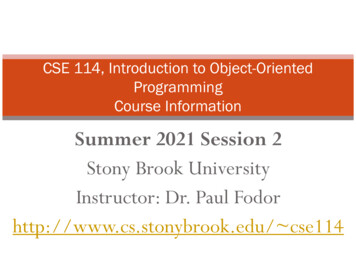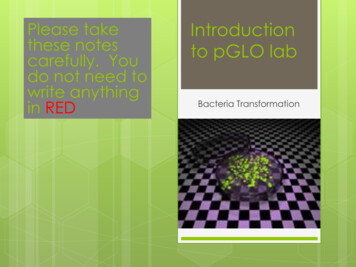
Transcription
Please takethese notescarefully. Youdo not need towrite anythingin REDIntroductionto pGLO labBacteria Transformation
What is a plasmid? Aplasmid is a small circular piece ofDNA (about 2,000 to 10,000 base pairs)that contains important geneticinformation for the growth of bacteria.
Often plasmids contains agene that codes for aprotein that will make thebacteria resistant to anantibiotic. Bacteria can exchangeplasmids with one another.Which helps more bacteriacells obtain the newplasmid
How do scientists useplasmids? Aplasmid containing resistance to anantibiotic (usually ampicillin) is used as avector. Avector is a vehicle for transferring foreigngenetic information
What do you do with plasmidsthat are now recombinantDNA? Afterfollowing the steps to combine abacterial plasmid with foreign DNA,scientists need to place the recombinantDNA into a living organism. The recombinant DNA is inserted into abacteria. Then the bacteria will express the new“foreign” DNA, and the bacteria willperform new functions.
What is transformation?The process of insertingrecombinant plasmid DNA into abacteria (or any other cell)GFPBacterialchromosomal DNAAmpResistancepGLO plasmids
How scientists make sure a bacteriacontains an altered plasmid? The transformed bacteria are then spread over an agarplate that contains ampicillin. only bacteria that have acquired the plasmid cangrow on the plate. The ampicillin provides a selective pressure because Selective Pressure - The same as in evolution - only theorganisms that have a particular trait (in this caseantibiotic resistance) will survive. Therefore, as long as you grow the bacteria inampicillin, it will need the plasmid to survive and it willcontinually replicate it, along with your gene of interestthat has been inserted to the plasmid.
Our lab is performingtransformation Wewill take a plasmid that has berecombined into a piece of recombinantDNA. This plasmid contains the original DNA aswell as a gene from a jellyfish. When transformation is complete, and weinsert the plasmid into a bacteria cell, thecell will express the jellyfish gene.
What jellyfish genewill we use? GFPis a green fluorescent protein that normally isfound in jellyfish In1987 Douglas Prasher thought that GFP from ajellyfish could be used to report when a protein wasbeing made in a cell. Proteins are extremely smalland cannot be seen, even under an electronmicroscope. However if one could somehow linkGFP to a specific protein, for example hemoglobin,one would be able to see the green fluorescenceof the GFP that is attached to the hemoglobin. Itwould be a bit like attaching a light bulb to thehemoglobin molecule.
Three 60 day old kittens. Two have been genetically modified tomake red fluorescent protein. All three look similar under normallight, but when irradiated with blue light only the two geneticallymodified kittens glow red.
Are we going to make kittens glow? No,just bacteria. Weare going to“transform” bacteria bymaking them take up acommercially preparedplasmid that containsthree genes of interest,ampR, araC and GFP. Genetically modifiedorganisms are“transgenic”
Genes of interest: amp, araC, GFP ampR– this gene will give our transgenicbacteria resistance to the antibiotic ampicillin araC – this gene will produce a protein in thepresence of arabinose that will allow thebacteria to turn on the GFP gene GFP – in the presence of arabinose, this genewill “turn on” and cause the transformed(transgenic) bacteria to glow green Thesethree genes will work together to allowgene regulation to be on, and for GFP to beexpressed.
Our Lab BacterialTransformation should occur! We will use several different agar plates inorder to see if the transformation wassuccessful.
How will we transform the bacteria?1.2.3.4.5.Suspend bacterial colonies in TransformationSolution, CaCl2Add pGLO plasmid DNA to DNA tubePlace tubes on iceHeat shock at 42oC and place on iceIncubate with LB broth.This process will make the bacteria take up theplasmid through its cell wall.
Explanation of agar plates E.coli starter plate This plate has thebacteria we will usegrowing in a luriabroth (LB) agarplate. These bacteria arenormal (have NOTbeen transformed)
Explanation of agar plates LB/-pGLO Thisis the control plate. These –DNAbacteria are not transformed and are innormal (LB) agar. You should expect to see normalbacterial growth in this plate.
Explanation of agar plates LB/amp/ pGLO Thisplate will have E. coli bacteria on LBagar to which ampicillin has been added. The pGLO means that the bacteria mayhave been transformed (if your technique isgood). If they have been transformed, they will nowhave a plasmid with an ampicillin resistantsite so they will not be killed by the ampicillinthat has been added to the agar.
Explanation of agar plates LB/amp/-pGLO These–pGLO bacteria have not receivedthe plasmid. They have not been transformed, so theydo not have resistance to the ampicillinthat is in the agar.
Explanation of agar plates LB/amp/ara/ pGLO Thisplate will havetransformed bacteria( pGLO) growing onagar that has bothampicillin and arabinoseadded to it. If your technique isgood, you shouldexpect to see greenglowing bacteria in thisplate.
In 1987 Douglas Prasher thought that GFP from a jellyfish could be used to report when a protein was being made in a cell. Proteins are extremely small and cannot be seen, even under an electron microscope. However if one could somehow link GFP to a specific protein, for example hemoglobin, one would be able to see the green fluorescence

